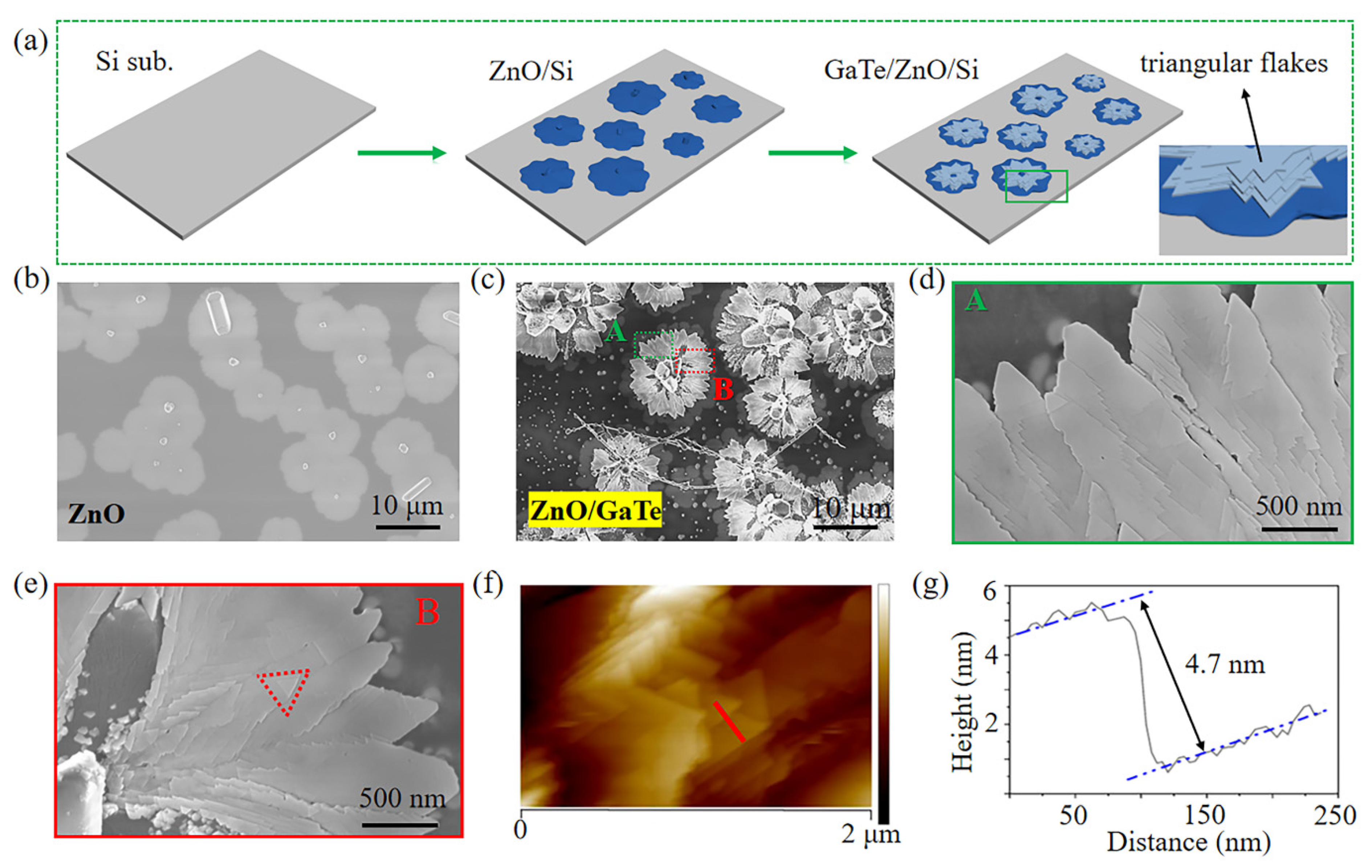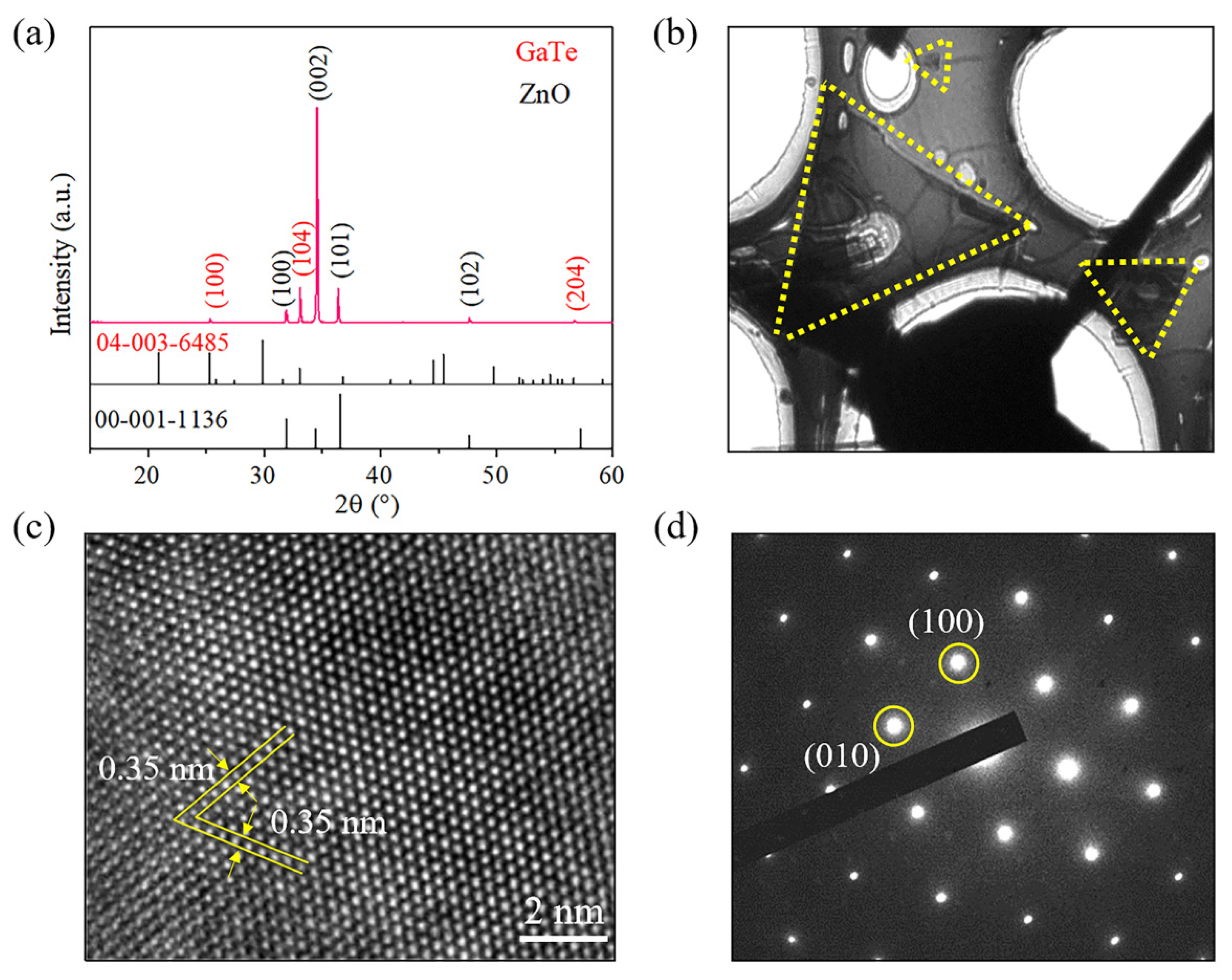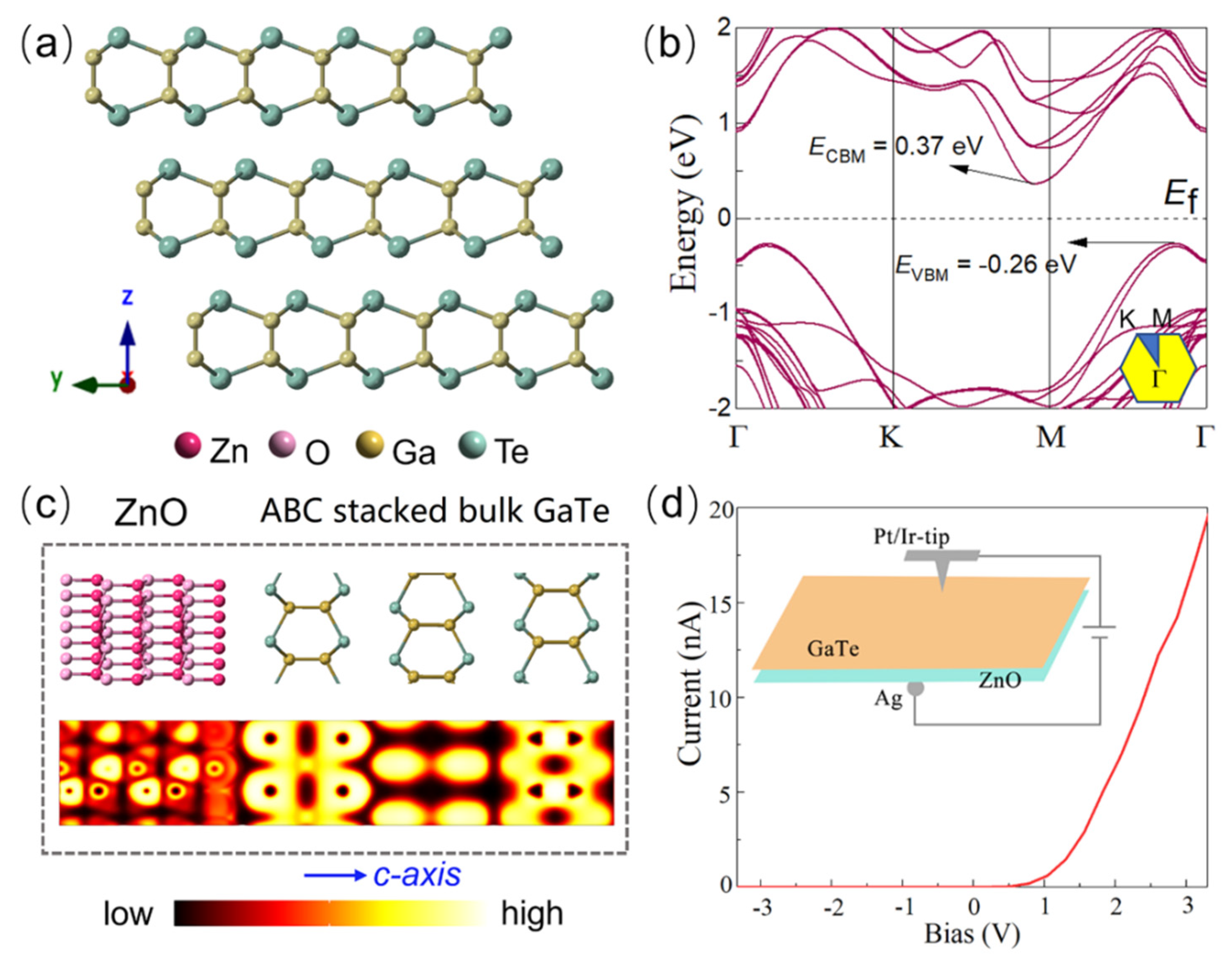The Growth of High-Quality Hexagonal GaTe Nanosheets Induced by ZnO Nanocrystals
Abstract
:1. Introduction
2. Experimental Section
2.1. Growth of ZnO Nanocrystals
2.2. Growth of GaTe
2.3. Material Characterization
2.4. DFT for the Atomic and Electronic Structures
3. Results and Discussion
4. Conclusions
Supplementary Materials
Author Contributions
Funding
Informed Consent Statement
Data Availability Statement
Acknowledgments
Conflicts of Interest
References
- Gibertini, M.; Koperski, M.; Morpurgo, A.F.; Novoselov, K.S. Magnetic 2D materials and heterostructures. Nat. Nanotechnol. 2019, 14, 408–419. [Google Scholar] [CrossRef] [PubMed] [Green Version]
- Novoselov, K.S.; Mishchenko, A.; Carvalho, A.; Castro Neto, A.H. 2D materials and van der Waals heterostructures. Science 2016, 353, 461–472. [Google Scholar] [CrossRef] [Green Version]
- Li, J.; Yang, X.; Liu, Y.; Huang, B.; Wu, R.; Zhang, Z.; Zhao, B.; Ma, H.; Dang, W.; Wei, Z.; et al. General synthesis of two-dimensional van der Waals heterostructure arrays. Nature 2020, 579, 368–374. [Google Scholar] [CrossRef] [PubMed]
- Dang, W.; Zhao, B.; Liu, C.; Yang, X.; Kong, L.; Lu, Z.; Li, B.; Li, J.; Zhang, H.; Li, W.; et al. Ultimate dielectric scaling of 2D transistors via van der Waals metal integration. Nano Res. 2022, 15, 1603–1608. [Google Scholar] [CrossRef]
- Chen, Z.; Chen, Q.; Chai, Z.; Wei, B.; Wang, J.; Liu, Y.; Shi, Y.; Wang, Z.; Li, J. Ultrafast growth of high-quality large-sized GaSe crystals by liquid metal promoter. Nano Res. 2021, 10, 40. [Google Scholar] [CrossRef]
- Chen, Z.; Liu, H.; Chen, X.; Chu, G.; Chu, S.; Zhang, H. Wafer-size and single-crystal MoSe2 atomically thin films grown on GaN substrate for light emission and harvesting. ACS Appl. Mater. Interfaces 2016, 8, 20267–20273. [Google Scholar] [CrossRef] [Green Version]
- Zólyomi, V.; Drummond, N.; Fal’Ko, V.I. Band structure and optical transitions in atomic layers of hexagonal gallium chalcogenides. Phys. Rev. B 2013, 87, 195403. [Google Scholar] [CrossRef] [Green Version]
- Zhuang, H.L.; Hennig, R.G. Single-layer group-III monochalcogenide photocatalysts for water splitting. Chem. Mater. 2013, 25, 3232–3238. [Google Scholar] [CrossRef]
- Chen, Z.; Zhang, Y.; Chu, S.; Sun, R.; Wang, J.; Chen, J.; Wei, B.; Zhang, X.; Zhou, W.; Shi, Y.; et al. Grain boundary induced ultralow threshold random laser in a single GaTe flake. ACS Appl. Mater. Inter. 2021, 12, 23323–23329. [Google Scholar] [CrossRef] [PubMed]
- Tan, J.; Nan, H.; Fu, Q.; Zhang, X.; Liu, X.; Ni, Z.; Ostrikov, K.; Xiao, S.; Gu, X. Fourfold polarization-sensitive photodetector based on GaTe/MoS2 van der waals heterojunction. Adv. Electron. Mater. 2022, 8, 2100673. [Google Scholar] [CrossRef]
- Wang, F.; Wang, Z.; Xu, K.; Wang, F.; Wang, Q.; Huang, Y.; Yin, L.; He, J. Tunable GaTe-MoS2 van der Waals p-n junctions with novel optoelectronic performance. Nano Lett. 2015, 15, 7558–7566. [Google Scholar] [CrossRef] [PubMed]
- Gillan, E.G.; Barron, A.R. Chemical vapor deposition of hexagonal Gallium Selenide and Telluride films from cubane precursors: Understanding the Envelope of Molecular Control. Chem. Mater. 1997, 9, 3037–3048. [Google Scholar] [CrossRef]
- Bae, C.J.; McMahon, J.; Detz, H.; Strasser, G.; Park, J.; Einarsson, E.; Eason, D.B. Influence of thickness on crystallinity in wafer-scale GaTe nanolayers grown by molecular beam epitaxy. AIP Adv. 2017, 7, 035113. [Google Scholar] [CrossRef] [Green Version]
- Cai, H.; Chen, B.; Wang, G.; Soignard, E.; Khosravi, A.; Manca, M.; Marie, X.; Chang, S.L.Y.; Urbaszek, B.; Tongay, S. Synthesis of highly anisotropic semiconducting GaTe nanomaterials and emerging properties enabled by epitaxy. Adv. Mater. 2017, 29, 1605551. [Google Scholar] [CrossRef] [PubMed] [Green Version]
- Tien, L.-C.; Shih, Y.-C. Morphology-controlled vapor phase growth and characterization of one-dimensional GaTe nanowires and two-dimensional nanosheets for potential visible-light active photocatalysts. Nanomaterials 2021, 11, 778. [Google Scholar] [CrossRef] [PubMed]
- Chen, Z.; Chu, S.; Chen, J.; Chen, H.; Zhang, J.; Ma, X.; Li, Q.; Chen, X. Epitaxially grown semi-vertical and aligned GaTe two dimensional sheets on ZnO substrate for energy harvesting applications. Nano Energy 2019, 56, 294–299. [Google Scholar] [CrossRef]
- Yu, Y.; Ran, M.; Zhou, S.; Wang, R.; Zhou, F.; Li, H.; Gan, L.; Zhu, M.; Zhai, T. Phase-engineered synthesis of ultrathin hexagonal and monoclinic GaTe flakes and phase transition study. Adv. Funct. Mater. 2019, 29, 1901012. [Google Scholar] [CrossRef]
- Liu, M.; Yang, S.; Han, M.; Feng, S.; Wang, G.-G.; Dang, L.; Zou, B.; Cai, Y.; Sun, H.; Yu, J.; et al. Controlled growth of large-sized and phase-selectivity 2D GaTe crystals. Small 2021, 21, 2007909. [Google Scholar] [CrossRef]
- Kosobutsky, A.V.; Sarkisov, S.Y. Influence of size effects on the electronic structure of hexagonal Gallium Telluride. Phys. Solid State 2018, 60, 1645–1649. [Google Scholar] [CrossRef]
- Kresse, G.; Furthmüller, J. Efficient Iterative Schemes for Ab initio total-energy calculations using a plane-wave basis set. Phys. Rev. B 1996, 54, 11169. [Google Scholar] [CrossRef]
- Kresse, G.; Joubert, D. From ultrasoft pseudopotentials to the projector augmented-wave method. Phys. Rev. B 1999, 59, 1758. [Google Scholar] [CrossRef]
- Klimeš, J.; Bowler, D.R.; Michaelides, A. Van der Waals density functionals applied to solids. Phys. Rev. B 2011, 83, 195131. [Google Scholar] [CrossRef] [Green Version]
- Kim, M.S.; Roy, S.; Lee, J.; Kim, B.G.; Kim, H.; Park, J.-H.; Yun, S.J.; Han, G.H.; Leem, J.-Y.; Kim, J. Enhanced light emission from monolayer semiconductors by forming heterostructures with ZnO thin films. ACS Appl. Mater. Int. 2016, 8, 28809–28815. [Google Scholar] [CrossRef] [PubMed]
- Ghoshal, T.; Biswas, S.; Kar, S.; Dev, A.; Chakrabarti, S.; Chaudhuri, S. Direct synthesis of ZnO nanowire arrays on Zn foil by a simple thermal evaporation process. Nanotechnology 2008, 19, 065606. [Google Scholar] [CrossRef] [PubMed]
- Balitskii, O.; Jaegermann, W. XPS study of InTe and GaTe single crystals oxidation. Mater. Chem. Phys. 2006, 97, 98–101. [Google Scholar] [CrossRef]
- Irwin, J.C.; Clayman, B.P.; Mead, D.G. Long-wavelength phonons in GaTe. Phys. Rev. B 1979, 19, 2099. [Google Scholar] [CrossRef]
- Cheng, C.; Liu, B.; Sie, E.J.; Zhou, W.; Zhang, J.; Gong, H.; Huan, C.H.A.; Sum, T.C.; Sun, H.; Fan, H.J. ZnCdO/ZnO coaxial multiple quantum well nanowire heterostructures and optical properties. J. Phys. Chem. C 2010, 114, 3863–3868. [Google Scholar] [CrossRef]
- Azarov, Y.A.; Zhang, T.C.; Svensson, B.G.; Kuznetsov, Y.A. Cd diffusion and thermal stability of CdZnO/ZnO heterostructures. Appl. Phys. Lett. 2011, 99, 111903. [Google Scholar] [CrossRef] [Green Version]
- Shenoy, U.S.; Gupta, U.; Narang, D.S.; Late, D.J.; Waghmare, U.V.; Rao, C.N.R. Electronic structure and properties of layered gallium telluride. Chem. Phys. Lett. 2016, 651, 148–154. [Google Scholar] [CrossRef]
- Li, J.; Chen, J.; Wang, H.; Chen, N.; Wang, Z.; Guo, L.; Deepak, F.L. In situ atomic-scale study of particle mediated nucleation and growth in amorphous Bi to nanocrystal phase transformation. Adv. Sci. 2018, 5, 1700992. [Google Scholar] [CrossRef]
- Li, J.; Lian, Z.; Li, Q.; Wang, Z.; Liu, L.; Deepak, F.L.; Liu, Y.; Li, B.; Xu, J.; Chen, Z. Boosting acidic water oxidation performance by constructing arrays-like nanoporous IrxRu1−xO2 with abundant atomic steps. Nano Res. 2022, 1–7. [Google Scholar] [CrossRef]
- Balitskii, O.A.; Jaeckel, B.; Jaegermann, W. Surface properties of GaTe single crystals. Phys. Lett. A 2008, 372, 3303–3306. [Google Scholar] [CrossRef]
- Liu, F.; Shimotani, H.; Shang, H.; Kanagasekaran, T.; Zólyomi, V.; Drummond, N.; Fal’ko, V.I.; Tanigaki, K. High-sensitivity photodetectors based on multilayer GaTe flakes. ACS Nano 2014, 8, 752–760. [Google Scholar] [CrossRef]
- Abudurusuli, A.; Huang, J.; Wang, P.; Yang, Z.; Pan, S.; Li, J. Li4MgGe2S7: The first alkali and alkaline-earth diamond-like infrared nonlinear optical material with exceptional large band gap. Angew. Chem. Int. Ed. 2021, 60, 24131–24136. [Google Scholar] [CrossRef] [PubMed]
- Yang, S.; Wang, C.; Ataca, C.; Li, Y.; Chen, H.; Cai, H.; Suslu, A.; Grossman, J.C.; Jiang, C.; Liu, Q.; et al. Self-driven photodetector and ambipolar transistor in atomically thin GaTe-MoS2 p-n vdW heterostructure. ACS Appl. Mater. Int. 2016, 8, 2533–2539. [Google Scholar] [CrossRef]
- Huang, S.; Tatsumi, Y.; Ling, X.; Guo, H.; Wang, Z.; Watson, G.; Puretzky, A.A.; Geohegan, D.B.; Kong, J.; Li, J.; et al. In-plane optical anisotropy of layered Gallium Telluride. ACS Nano 2016, 10, 8964–8972. [Google Scholar] [CrossRef]
- Hu, P.; Zhang, J.; Yoon, M.; Qiao, X.-F.; Zhang, X.; Feng, W.; Tan, P.; Zheng, W.; Liu, J.; Wang, X.; et al. Highly sensitive phototransistors based on two-dimensional GaTe nanosheets with direct bandgap. Nano Res. 2014, 7, 694–703. [Google Scholar] [CrossRef]
- Alim, K.A.; Fonoberov, V.A.; Shamsa, M.; Balandin, A.A. Micro-raman investigation of optical phonons in ZnO nanocrystals. J. Appl. Phys. 2005, 97, 124313. [Google Scholar] [CrossRef] [Green Version]
- Yang, T.; Hertenberger, S.; Morkötter, S.; Abstreiter, G.; Koblmüller, G. Size, composition, and doping effects on In(Ga)As nanowire/Si tunnel diodes probed by conductive atomic force microscopy. Appl. Phys. Lett. 2012, 101, 233102. [Google Scholar] [CrossRef]
- Wang, P.; Chu, Y.; Tudi, A.; Xie, C.; Yang, Z.; Pan, S.; Li, J. The combination of structure prediction and experiment for the exploration of alkali-earth metal-contained chalcopyrite-like IR nonlinear optical material. Adv. Sci. 2022, 2106120, 1–9. [Google Scholar] [CrossRef]
- Chu, Y.; Wang, P.; Zeng, H.; Cheng, S.; Su, X.; Yang, Z.; Li, J.; Pan, S. Hg3P2S8: A new promising infrared nonlinear optical material with a large second-harmonic generation and a high laser-induced damage threshold. Chem. Mater. 2021, 33, 6514–6521. [Google Scholar] [CrossRef]
- He, J.H.; Ho, C.H. The study of electrical characteristics of heterojunction based on ZnO nanowires using ultrahigh-vacuum conducting atomic force microscopy. Appl. Phys. Lett. 2007, 91, 233105. [Google Scholar] [CrossRef]





Publisher’s Note: MDPI stays neutral with regard to jurisdictional claims in published maps and institutional affiliations. |
© 2022 by the authors. Licensee MDPI, Basel, Switzerland. This article is an open access article distributed under the terms and conditions of the Creative Commons Attribution (CC BY) license (https://creativecommons.org/licenses/by/4.0/).
Share and Cite
Chen, Q.; Chen, Y.; Wang, J.; Liu, M.; Chen, Z. The Growth of High-Quality Hexagonal GaTe Nanosheets Induced by ZnO Nanocrystals. Crystals 2022, 12, 627. https://doi.org/10.3390/cryst12050627
Chen Q, Chen Y, Wang J, Liu M, Chen Z. The Growth of High-Quality Hexagonal GaTe Nanosheets Induced by ZnO Nanocrystals. Crystals. 2022; 12(5):627. https://doi.org/10.3390/cryst12050627
Chicago/Turabian StyleChen, Quan, Yu Chen, Jun Wang, Meizhuang Liu, and Zuxin Chen. 2022. "The Growth of High-Quality Hexagonal GaTe Nanosheets Induced by ZnO Nanocrystals" Crystals 12, no. 5: 627. https://doi.org/10.3390/cryst12050627
APA StyleChen, Q., Chen, Y., Wang, J., Liu, M., & Chen, Z. (2022). The Growth of High-Quality Hexagonal GaTe Nanosheets Induced by ZnO Nanocrystals. Crystals, 12(5), 627. https://doi.org/10.3390/cryst12050627





